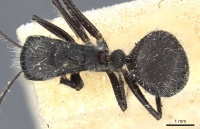Camponotus wasmanni
| Camponotus wasmanni | |
|---|---|

| |
| Scientific classification | |
| Kingdom: | Animalia |
| Phylum: | Arthropoda |
| Class: | Insecta |
| Order: | Hymenoptera |
| Family: | Formicidae |
| Subfamily: | Formicinae |
| Tribe: | Camponotini |
| Genus: | Camponotus |
| Species: | C. wasmanni |
| Binomial name | |
| Camponotus wasmanni Emery, 1893 | |
Identification
Keys including this Species
Distribution
Latitudinal Distribution Pattern
Latitudinal Range: 32.628611° to 20.92583°.
| North Temperate |
North Subtropical |
Tropical | South Subtropical |
South Temperate |
- Source: AntMaps
Distribution based on Regional Taxon Lists
Oriental Region: Bangladesh, India (type locality).
Palaearctic Region: China.
Distribution based on AntMaps
Distribution based on AntWeb specimens
Check data from AntWeb
Countries Occupied
| Number of countries occupied by this species based on AntWiki Regional Taxon Lists. In general, fewer countries occupied indicates a narrower range, while more countries indicates a more widespread species. |

|
Estimated Abundance
| Relative abundance based on number of AntMaps records per species (this species within the purple bar). Fewer records (to the left) indicates a less abundant/encountered species while more records (to the right) indicates more abundant/encountered species. |

|
Biology
Castes
Images from AntWeb

| |
| Syntype of Camponotus wasmanni. Worker. Specimen code casent0905413. Photographer Z. Lieberman, uploaded by California Academy of Sciences. | Owned by MSNG, Genoa, Italy. |
Nomenclature
The following information is derived from Barry Bolton's Online Catalogue of the Ants of the World.
- wasmanni. Camponotus wasmanni Emery, 1893e: 224 (s.w.q.) INDIA (Sikkim).
- Type-material: holotype minor worker.
- [Note: in the original description Emery includes major and minor workers and a queen, but then implies that the type-material is a single minor worker, “Typus….un exemplaire”.]
- Type-locality: India: Himalaya, Sikkim (Wasmann).
- Type-depository: MSNG.
- Combination in C. (Myrmepomis): Forel, 1912i: 92;
- combination in C. (Orthonotomyrmex): Emery, 1920b: 258; Santschi, 1921f: 310.
- Status as species: Forel, 1895e: 453 (redescription); Emery, 1896d 376 (in list); Bingham, 1903: 375; Forel, 1906b: 85; Emery, 1925b: 126; Donisthorpe, 1929a: 448; Menozzi, 1939a: 316 (in key); Chapman & Capco, 1951: 242; Bolton, 1995b: 129; Mathew & Tiwari, 2000: 356; Zhou, 2001b: 213; Karmaly & Narendran, 2006: 132; Ran & Zhou, 2011: 70; Guénard & Dunn, 2012: 30; Bharti & Wachkoo, 2014a: 7 (in key); Bharti, Guénard, et al. 2016: 26.
- Distribution: China, India, Myanmar.
Description
References
- Chanda, A. 2017. A study on ants (Hymenoptera: Formicidae) of Medinipur, West Bengal, India. International Journal of Entomological Research 2(5): 1-4.
- Dendup, K.C., Dorji, C., Dhadwal, T., Bharti, H., Pfeiffer, M. 2021. A preliminary checklist of ants from Bhutan. Asian Myrmecology 14, e014005 (doi:10.20362/am.014005).
- Emery, C. 1893g. Formicides de l'Archipel Malais. Rev. Suisse Zool. 1: 187-229 (page 224, soldier, worker, queen described)
- Emery, C. 1920b. Le genre Camponotus Mayr. Nouvel essai de la subdivision en sous-genres. Rev. Zool. Afr. (Bruss.) 8: 229-260 (page 258, Combination in C. (Orthonotomyrmex))
- Forel, A. 1895f. Les Formicides de l'Empire des Indes et de Ceylan. Part V. J. Bombay Nat. Hist. Soc. 9: 453-472 (page 453, male described)
- Forel, A. 1912j. Formicides néotropiques. Part VI. 5me sous-famille Camponotinae Forel. Mém. Soc. Entomol. Belg. 20: 59-92 (page 92, Combination in C. (Myrmepomis))
- Khachonpisitsak, S., Yamane, S., Sriwichai, P., Jaitrong, W. 2020. An updated checklist of the ants of Thailand (Hymenoptera, Formicidae). ZooKeys 998, 1–182 (doi:10.3897/zookeys.998.54902).
- Subedi, I.P., Budha, P.B., Bharti, H., Alonso, L., Yamane, S. 2021. First record of the ant subgenus Orthonotomyrmex of the genus Camponotus from Nepal (Hymenoptera, Formicidae). Zoodiversity 55, 279–284 (doi:10.15407/zoo2021.04.279).
References based on Global Ant Biodiversity Informatics
- Bharti H., Y. P. Sharma, M. Bharti, and M. Pfeiffer. 2013. Ant species richness, endemicity and functional groups, along an elevational gradient in the Himalayas. Asian Myrmecology 5: 79-101.
- Cheng D., Z. Chen, and S. Zhou. 2015. An analysis on the ant fauna of Jinzhongshan Nature Reserve in Gunagxi, China. Journal of Guangxi Normal University: Natural Science Edition 33(3): 129.137.
- Emery C. 1893. Formicides de l'Archipel Malais. Revue Suisse de Zoologie 1: 187-229.
- Forel A. 1906. Les fourmis de l'Himalaya. Bulletin de la Société Vaudoise des Sciences Naturelles 42: 79-94.
- Hua Li-zhong. 2006. List of Chinese insects Vol. IV. Pages 262-273. Sun Yat-sen university Press, Guangzhou. 539 pages.
- Li Z.h. 2006. List of Chinese Insects. Volume 4. Sun Yat-sen University Press
- Mathew R., and R. N. Tiwari. 2000. Insecta: Hymenoptera: Formicidae. Pp. 251-409 in: Director; Zoological Survey of India (ed.) 2000. Fauna of of Meghalaya. Part 7. [State Fauna Series 4.] Insecta 2000. Calcutta: Zoological Survey of India, 621 pp.
- Ran H., and S. Y. Zhou. 2011. Checklist of Chinese Ants: the Formicomorph Subfamilies (Hymenoptera: Formicidae) (I). Journal of Guangxi Normal University: Natural Science Edition. 29(3): 65-73.

